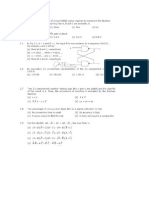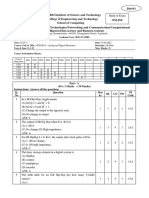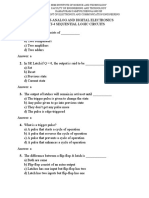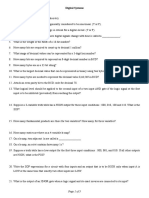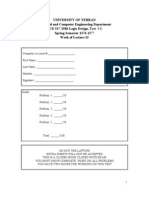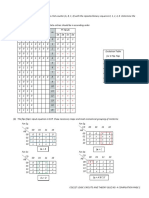0 ratings 0% found this document useful (0 votes) 30 views 28 pages Sequential Circuit 08 - Class Notes
The document discusses various configurations and behaviors of digital circuits, particularly focusing on flip-flops, multiplexers, and counters. It includes specific examples of state sequences, propagation delays, and the minimum number of flip-flops needed for certain counter designs. The content is structured around multiple-choice questions from a GATE examination format, testing knowledge on synchronous sequential circuits.
AI-enhanced title and description
Copyright
© © All Rights Reserved
We take content rights seriously. If you suspect this is your content,
claim it here .
Available Formats
Download as PDF or read online on Scribd
Go to previous items Go to next items
Save Sequential Circuit 08 _ Class Notes For Later teed
The output of a 2-input multiplexer is connected back to one of its inputs as
Soar B enn itst laos
Match the function equivalence of this circuit to one of the following options.
emt
!
Deity
Latch
© haltadder X
[GATE-2023-CS: 1M]
Rms
S=9, Q(ntl)= Q(n)
Cena
tp) yee eesti aon
ma7) Oe) Dei�#Q. Given below is the diagram of a synchronous sequential circuit ae)
one J-K flip-flop and one T flip-flop with their outputs denoted as A and
B respectively, with J, = (A' + B'), K, = (A+B), and T, = A.
Starting from the initial state (AB = 00), the sequence of states (AB)
Siem aero ie ry
aa
eee ee emer) ora
ea)
Sh OAR on Le)
Cy il ee eo) —) >
eT) KW Pt
Ce el ee
felted
bo0- ol I-06 ote�tee)
Consider a combination of T and D flip-flops connected as shown below. The
output of the D flip-flop is connected to the input of the T flip-flop and the
output of the T flip-flop is connected to the input of the D flip-flop.
Initially, both Q, and Q, are set to 1 (before the 1st clock cycle). The outputs
[GATE-2017-CS: 1M]
TIPE TCH GD)
Re CtLeADIC“ OCD can ri Ca va! aT
ONCE) ae HT) id sins ny a i
Clock a ic
(a Q,Q) after the 3rd cycle are 11 and after the 4th cycle ES tit) ae
Q,Q after the 3rd cycle are 11 and after the 4th cycle are 01 respectively
Cc) CRON cg the 3rd cycle are 00 and after the 4th cycle are 11 respectively
CD) Q,Q) afté the 3rd cycle are 01 and after the 4th cycle are 01 respectively.�#Q. The propagation delay of the exclusive-OR (XOR) gate in the circuit mi
Ue ite ce eM UCR yee lect cl MeOC MMe ee Memo eeceee coin
to be zero. The clock (CLK) frequency provided to the circuit is 500
tr
Nem ei MOM CMC Re mealies iene ion ticRe mere ts as ase
with D, = 1, the minimum number of triggering clock edges after
which the flip-flop outputs Q, Q,; Q), becomes 1 0 0
(Cebtcsoe ety�Cee)
A positive edge-triggered D flip-flop is connected to a positive edge-triggered JK
flip-flop as follows. The Q output of the D flip-flop is connected to both the J and
K inputs of the JK flip-flop, while the Q output of the JK flip-flop is connected to
UIT me Mem PMI ios teem ET iec Amer melee ime mere DM i lente om Kea com los la
one and the output of the JK flip-flop is cleared. Which one of the following is the
bit sequence (including the initial state) generated at the Q output of the JK flip-
FIC MOV Mence ited ie) e te mae eae ok Wicca nil -meeunietme ele eames n
that J = K = 1 is the toggle mode and J = K = 0 is the state-holding mode of the JK
ou Both the flip-flops have non-zero propagation delays. [GATE-2015-CS: 1M]
CSET SOC acne Ah RA i LTE Oe EON CNT NC
OX or00100.. » —&lnty = Do= Qin)
©% 011101110.
© % 011001100...�a�ite)
The above synchronous sequential circuit built using JK flip-flops is initialized
Rive) 2:Q,Q0 = 000. The state sequence for this circuit for the next 3 clock cycles
H [GATE-2014-CS: 1M]
Bs
- z , CA
c “ ; a d c o a ae)
fs kK & 7 ion or)
ar)
rh jl M4
Ch ESAT A USE Te
a —— —
001, 010, 011 eo roe
OX111, 110, 101 crc oe = Qn)
SCT ECC Ee Re oa Tear OEChES)
100, 011, 001�ite)
The minimum number of D flip-flops needed to design a mod-258 counter is :
am [GATE-2011-CS: 1M]
oo
nN
ar
i)
ay
ry
iy�#Q. Two T-flip flops are interconnected as shown in the figure. The — |}
state of the flip flops are: A = 1, B = 1. The input x is given as 1, 0, 1 in
the next three clock cycles. The decimal equivalent of (ABy), with A
being the MSB and y being the LSB, after the 3" clock cycle is ___7
CTO RPE SCR SGD) Wee
ECT CR RECT) ie 1) Hl
UNCED aa ACE TIED) tea Py .
ea OD)�[McQ] Ch,
LOS omentm Ce ehiUiel Matval imi Ve Mult Mele om Page eile ieee eRe Meseciiy
type of counter configuration. If all the flip-flops were reset to 0 at power on,
what is the total number of distinct outputs (states) represented by PQR
Poneto ECC mee [GATE-2011-CS: 1M]
CCE aay S00) CEM
(2. da CLD ic a
o Se Aa eat a ae
are a
5 a .
i
Ce Be�[McQ] Ch,
Oops omentm Ce oUt Metvar imi Ve hui melet om Page miles ieee Be Meseciiy
type of counter configuration. If at some instance prior to the occurrence of the
alle aes ORM CL MRO ee aceon ARE areca ee
value of PQR after the clock edge? [GATE-2011-CS: 1M]
aa
Ca
© 001
© 010
O ou�tee)
Consider a sequential digital circuit consisting of T flip-flops and D flip-flops as
SoBe te omO OM CBC Reme lee aiietimcmeteratiam memoria On om
Q2 and Q3 have values 0, 1 and 1, respectively.
Which one of the given values of (Q1, Q2, Q3) can NEVER be obtained with this
digital circuit? Cet eg [GATE-2023-CS: 2M]
Teil
(0, 0, 1) COT nO) CAS
a TOTO NC) wit
( : SICH) mane tS sa one
\ mee
ie
ec re
ary
s(n) #5 ca
if
eats ce D)�Lockout
(Caro Shag WA
Ces
(otl)— *
eeeas er
ea aes
; meme ast ¢
oe
(-- oe |.
ri�tee)
Consider a 3-bit counter, designed using T flip-flops, as shown below.
Assuming the initial state of the counter given by PQR as 000. What are the next
Por ced
011,101,000
RSS St
SRS Et
001,010,000
ia
Vise eee TTT�#Q. For the synchronous sequential circuit shown below, the output Z mi)
PZaveR oomere nec mae te (eli)
OT Tk ON ete OLY
The minimum number of clock cycles after which the output z would
again become zero is�Oo Do�[NAT]
The minimum number of JK flip-flops required to construct a synchronous
eet tet) A count sequence (0,0,1,1,2,2,3,3,0,0....jis. [GATE-2021-CS: 2M]
a
10 el ee oa 9
. pa aoa
d
i
00 oa
| (eke) roma oo O|
(anne) | ao lo| ae
Ca ve
ees '
ror]
a
i�Ce No beaa Sied?ol|
ad
CRs ale SY
ees
= 9
ry anal
CT
rT
cama}
xa ey
nT
anor
Seay
cas
aT
eo- 3a
a
oop
R2Q, 2
a ea aera�ro
1B
Which one of the following statements is true about the digital circu QD
Stem mer mittee
It can be used for dividing the input frequency by 3.
Itcan be used for dividing input frequency by 5.
sTaeT eM IO CO MeUC TMU eet eect ae
It cannot be reliably used as a frequency divider due to disjoint internal cycles.�tee)
The next state table of a 2-bit saturating up-counter is given below.
The counter is built as a synchronous sequential circuit using T flip-flops.
The expressions for T, and Ty are
a
° SLC a eer Oy
° SEO Ory
tc} SERCO a0
[BAO
GATE-2017-CS: 1M]
(Fae ee
0/0 ) a
ame a 0
1| 0 ss Bf
jee sg Ee�ite)
Consider a 4-bit Johnson counter an initial value of 0000. The counting
sequence of this counter is - [GATE-2015-CS: 1M]
lee ooh ileal
ek-y- eee CONN
ieaneysy aon
© 013,7,15,14,12,8,0
© 01355,7,9,11,13,15,0
© 0246,8,10,12,14,0
ro Aa STEERED�ite)
Let k = 2". A circuit is built by giving the output of an n-bit binary counter as
input to an n-to- 2" bit decoder. This circuit is equivalent to a
ne CBD) Q2. QQ.
n
Cs Moora ena ce a Co)
CB ) ea Sets Reel ae ae
OK ring counter. Z
k-bit Johnson counter.
CV pe Moe TT]
nn
el °
[on ee! ee ee
a bier ee
Cee Te mee nr)
4. sd 0 .
a
By aie Rea cas�#Q. A three-bit pseudo random number generator is shown. Initially nc
value of output Y = Y, Y, Yo is set to 111. The value of output Y after
three clock cycles is
000
> Dp,
CCE CD)
Ro(nt) =& ln) t t 1
xo Ss co
= By(nyBa(n) Sh ae
|
one
oy oa�ro
The circuit shown consists of J-K flip-flops, each with an active iow
asynchronous reset (Ry input). The counter corresponding to this
circuit is
EBC mune ma Reeth a
Eee Onmo nem acme ios
Eten enema meet ics
a modulo-6 binary up counter�#Q. For the circuit shown, the clock frequency is f, and the duty cycle @
25%, For the signal at the Q output of the Flip-Flop, "
aad
Eos Flip-Flop
nak
frequency is f,/4 and duty cycle is 50%
frequency is f,/4 and duty cycle is 25%
ieee MCS PA Rel ame cee LL)
frequency is f) and duty cycle is 25%�#Q. In the following sequential circuit, the initial state (before the rsh
clock pulse) of the circuit is Q; Qy = 00. The state (Q, Q,), immediately
after the 333 clock pulse is
ad
00
2|�#Q. The figure shows a digital circuit constructed using negative cae
triggered J-K a flops. Assume a starting state of Q, Q; Q, = 000 will
number of cycles of the clock CLK
repeat after
Qo(ntt)= Qa(n)
SEE eae ae — 7
CONC Es Att aL Sa Qalt-ey)
CTICD) CCS aly Q@\(v) EST Ea�COST
|
le
Ae
i ons
i
nn)
ao
cn)
ae
Ooo
sh |
a Ie



